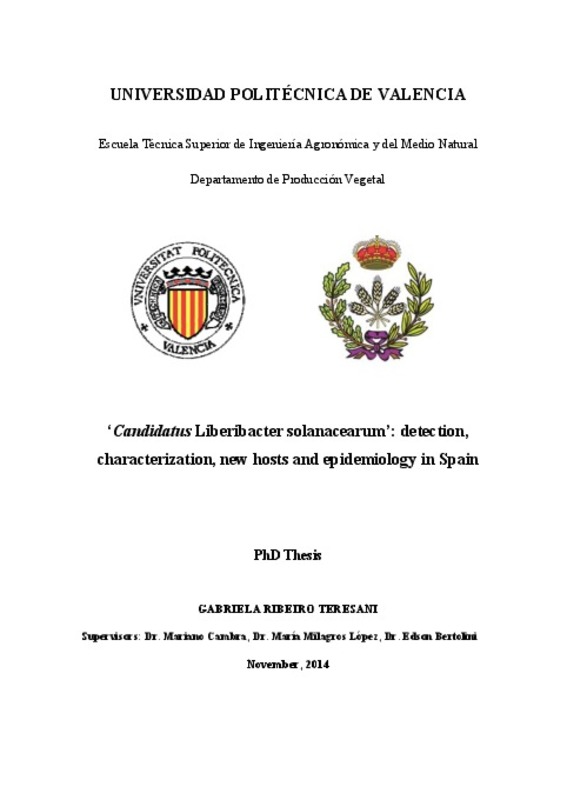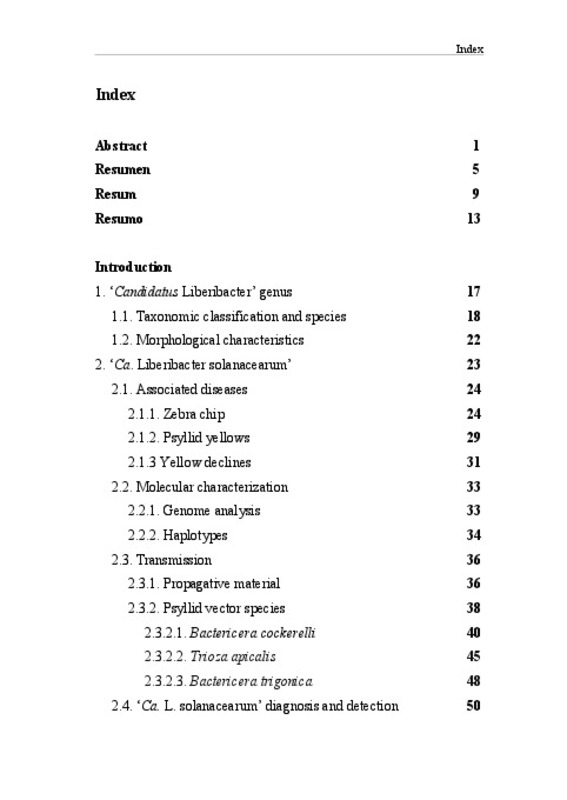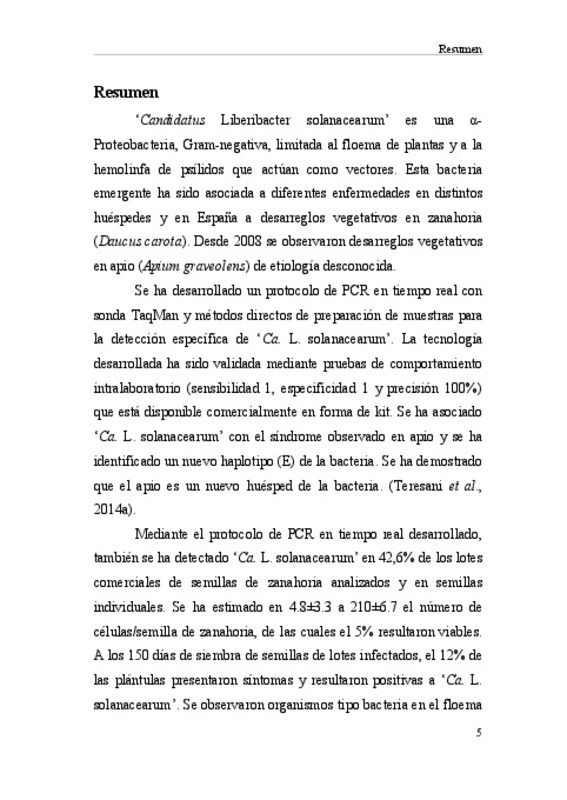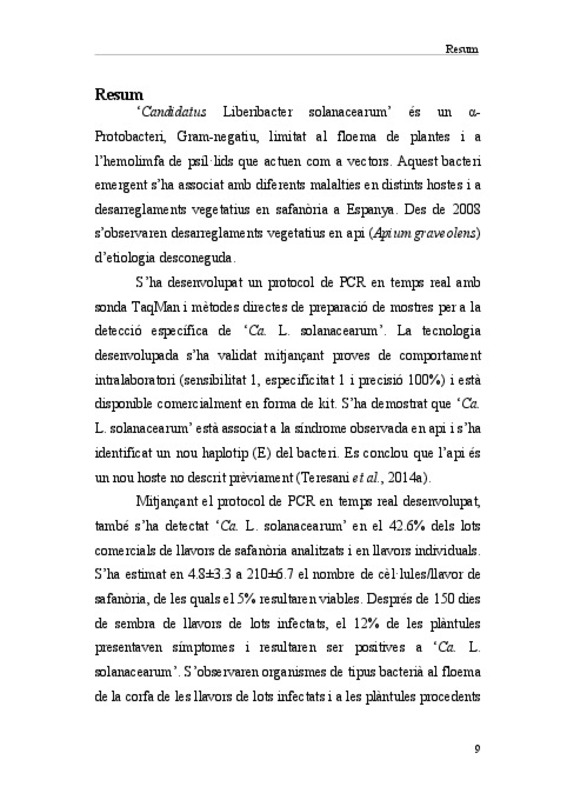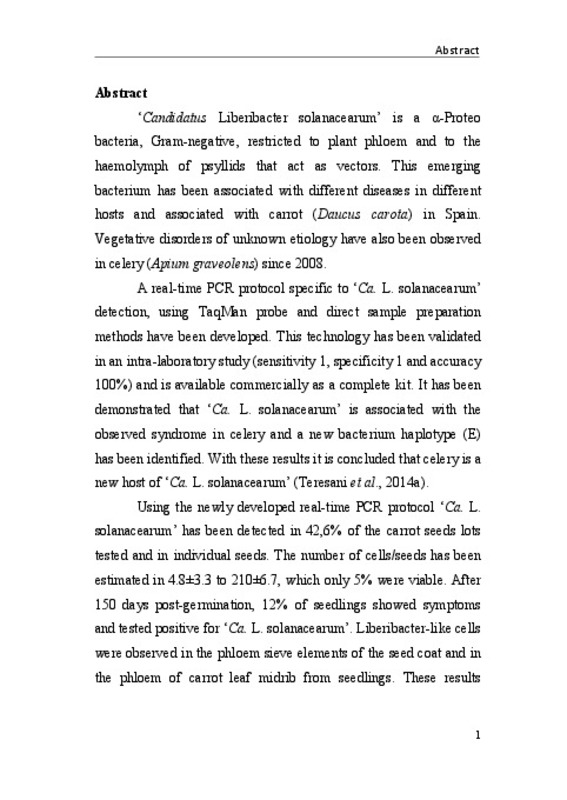- RiuNet repositorio UPV
- :
- Investigación
- :
- Tesis doctorales
- :
- Ver ítem
JavaScript is disabled for your browser. Some features of this site may not work without it.
Buscar en RiuNet
Listar
Mi cuenta
Estadísticas
Ayuda RiuNet
Admin. UPV
Candidatus Liberibacter solanacearum: detection, characterization, new hosts and epidemiology in Spain
Mostrar el registro sencillo del ítem
Ficheros en el ítem
| dc.contributor.advisor | Bertolini, Edson
|
es_ES |
| dc.contributor.advisor | Cambra Alvarez, Mariano J.
|
es_ES |
| dc.contributor.advisor | Lopez Gonzalez, Maria Milagros
|
es_ES |
| dc.contributor.author | Ribeiro Teresani, Gabriela
|
es_ES |
| dc.date.accessioned | 2015-03-30T11:14:13Z | |
| dc.date.available | 2015-03-30T11:14:13Z | |
| dc.date.created | 2014-12-11 | es_ES |
| dc.date.issued | 2015-12-11 | es_ES |
| dc.identifier.uri | http://hdl.handle.net/10251/48459 | |
| dc.description | Tesis por compendio | es_ES |
| dc.description.abstract | ‘Candidatus Liberibacter solanacearum’ is a α-Proteo bacteria, Gram-negative, restricted to plant phloem and to the haemolymph of psyllids that act as vectors. This emerging bacterium has been associated with different diseases in different hosts and associated with carrot (Daucus carota) in Spain. Vegetative disorders of unknown etiology have also been observed in celery (Apium graveolens) since 2008. A real-time PCR protocol specific to ‘Ca. L. solanacearum’ detection, using TaqMan probe and direct sample preparation methods have been developed. This technology has been validated in an intra-laboratory study (sensitivity 1, specificity 1 and accuracy 100%) and is available commercially as a complete kit. It has been demonstrated that ‘Ca. L. solanacearum’ is associated with the observed syndrome in celery and a new bacterium haplotype (E) has been identified. With these results it is concluded that celery is a new host of ‘Ca. L. solanacearum’ (Teresani et al., 2014a). Using the newly developed real-time PCR protocol ‘Ca. L. solanacearum’ has been detected in 42,6% of the carrot seeds lots tested and in individual seeds. The number of cells/seeds has been estimated in 4.8±3.3 to 210±6.7, which only 5% were viable. After 150 days post-germination, 12% of seedlings showed symptoms and tested positive for ‘Ca. L. solanacearum’. Liberibacter-like cells were observed in the phloem sieve elements of the seed coat and in the phloem of carrot leaf midrib from seedlings. These results demonstrated that ‘Ca. L. solanacearum’ is transmitted by carrot seeds (Bertolini et al., 2014b). The collected arthropods were classified into families, and the superfamily Psylloidea was identified to the species level resulting Bactericera trigonica, B. tremblayi and B. nigricornis the main identified species. The population dynamics of different psyllids species visiting carrot, celery and potato has been determined, concluding that the highest populations are captured during summer. The bacterium has been detected in the different Bactericera species previous cited additionally to Bactericera sp. The psyllid species carrying the bacteria can be considered as possible vectors of the bacterium (Teresani et al. 2014b). Electrical Penetration Graphs showed that B. trigonica was able to feed in the phloem of carrot, celery and potato but not in the phloem of tomato plants. Experimental transmission showed that B. trigonica transmitted ‘Ca. L. solanacearum’ from carrot to carrot, celery, potato and tomato. More efficient transmission occurred with ten individuals, and the transmission rates were 100% in celery, 80% in carrot and 10% in potato and tomato. The experimental transmission to potatoes threatens this crop (Teresani et al., 2014c). These combined results have built a scientific foundation of the biological and epidemiological aspects of ‘Ca. L. solanacearum’ contributing to new scientific information that is key in cultivation of celery and carrot to establish bacteria control strategies. The use of bacteria-free carrot seed lots will definitely contribute to mitigate damage and reduce risks of transmission to solanaceous crops. | en_EN |
| dc.language | Inglés | es_ES |
| dc.publisher | Universitat Politècnica de València | es_ES |
| dc.rights | Reserva de todos los derechos | es_ES |
| dc.subject | Bacterium | es_ES |
| dc.subject | 'Ca. L. solanacearum' | es_ES |
| dc.subject | Detection | es_ES |
| dc.subject | Quantification | es_ES |
| dc.subject | Cell viability | es_ES |
| dc.subject | Real-time PCR | es_ES |
| dc.subject | Seedborne bacterium | es_ES |
| dc.subject | Electron microscopy | es_ES |
| dc.subject | Bactericera sp | es_ES |
| dc.subject | Celery | es_ES |
| dc.subject | Carrot | es_ES |
| dc.title | Candidatus Liberibacter solanacearum: detection, characterization, new hosts and epidemiology in Spain | es_ES |
| dc.type | Tesis doctoral | es_ES |
| dc.identifier.doi | 10.4995/Thesis/10251/48459 | es_ES |
| dc.rights.accessRights | Abierto | es_ES |
| dc.contributor.affiliation | Universitat Politècnica de València. Departamento de Producción Vegetal - Departament de Producció Vegetal | es_ES |
| dc.description.bibliographicCitation | Ribeiro Teresani, G. (2014). Candidatus Liberibacter solanacearum: detection, characterization, new hosts and epidemiology in Spain [Tesis doctoral no publicada]. Universitat Politècnica de València. https://doi.org/10.4995/Thesis/10251/48459 | es_ES |
| dc.description.accrualMethod | TESIS | es_ES |
| dc.type.version | info:eu-repo/semantics/acceptedVersion | es_ES |
| dc.relation.pasarela | TESIS\6476 | es_ES |
| dc.description.compendio | Compendio | es_ES |
Este ítem aparece en la(s) siguiente(s) colección(ones)
-
Tesis doctorales [5284]






